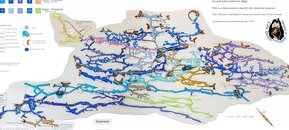I think a lot of tactics intended to boost situational awareness end up being more distracting than helpful. For example, noting an accurate compass direction or the classic "thumbs up, index finger pointing to the exit" at every decision point on the way out, while still relying on team markers on the way in. Techniques like these can turn into distractions instead of genuine aids.
Instead, get your head out of your wetnotes, look around, and commit the cave to memory. Having a sense of direction (N, E, S, W—or even eight directions if you're up for it) is valuable, but only if you can mentally anchor that to actual cave features.
My best tip for building awareness? Focus on the cave itself instead of fixating on the line. Yes, always know where the line is, but it’s not going to disappear if you take time to observe the cave around you.
A solid navigation system is straightforward: always place your own markers on the exit side of every decision point—no exceptions. You don’t need a cave navigation book for this; just make it a habit to mark the exit side, every time. It’s that simple.
Awareness goes beyond just markers and rough direction. Pay attention to things like arrow orientations; they can change, even in popular caves in Mexico. And remember, explorers aren’t infallible. Mistakes happen, and sometimes navigation gets harder than it should be, with blind T’s or missing directional markers on jumps. In some places, navigation is even intentionally challenging, with hidden jumps and no markers (which I think borders on insane but is sometimes just part of diving in Mexico).
Ultimately, awareness as a safety tool only comes into play after your navigation system fails. Developing the kind of awareness that lets you think, “I wasn’t here before,” “I should be heading in X direction,” or “Let’s go back and figure out where we messed up” is the most critical skill you can build.
Instead, get your head out of your wetnotes, look around, and commit the cave to memory. Having a sense of direction (N, E, S, W—or even eight directions if you're up for it) is valuable, but only if you can mentally anchor that to actual cave features.
My best tip for building awareness? Focus on the cave itself instead of fixating on the line. Yes, always know where the line is, but it’s not going to disappear if you take time to observe the cave around you.
A solid navigation system is straightforward: always place your own markers on the exit side of every decision point—no exceptions. You don’t need a cave navigation book for this; just make it a habit to mark the exit side, every time. It’s that simple.
Awareness goes beyond just markers and rough direction. Pay attention to things like arrow orientations; they can change, even in popular caves in Mexico. And remember, explorers aren’t infallible. Mistakes happen, and sometimes navigation gets harder than it should be, with blind T’s or missing directional markers on jumps. In some places, navigation is even intentionally challenging, with hidden jumps and no markers (which I think borders on insane but is sometimes just part of diving in Mexico).
Ultimately, awareness as a safety tool only comes into play after your navigation system fails. Developing the kind of awareness that lets you think, “I wasn’t here before,” “I should be heading in X direction,” or “Let’s go back and figure out where we messed up” is the most critical skill you can build.





